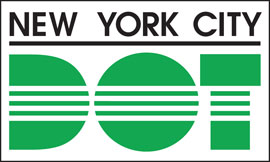
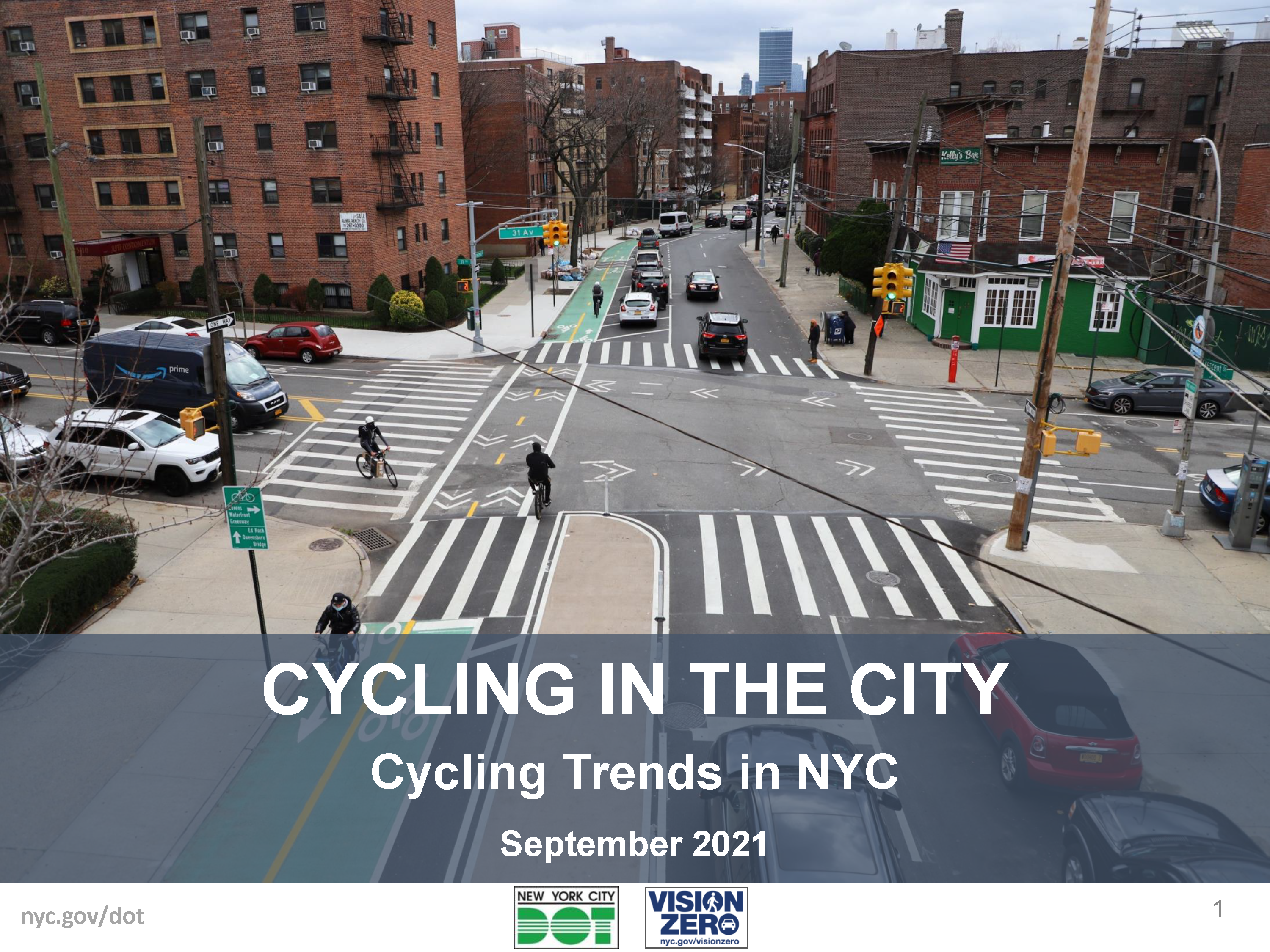
Cycling in the City - 2021
NYC DOT is pleased to announce the newest release of Cycling in the City, an annualized report on cycling trends in New York City. This brief examines data from the New York City Community Health Survey and national surveys, on-going bike counts, and Citi Bike to assess how frequently New Yorkers are using cycling as a mode of transportation and how that frequency is changing over time.
Cycling in the City - 2021 (PDF)
Cycling in the City - 2021

NYC DOT is pleased to announce the newest release of Cycling in the City, an annualized report on cycling trends in New York City. This brief examines data from the New York City Community Health Survey and national surveys, on-going bike counts, and Citi Bike to assess how frequently New Yorkers are using cycling as a mode of transportation and how that frequency is changing over time.
Cycling in the City - 2021 (PDF)
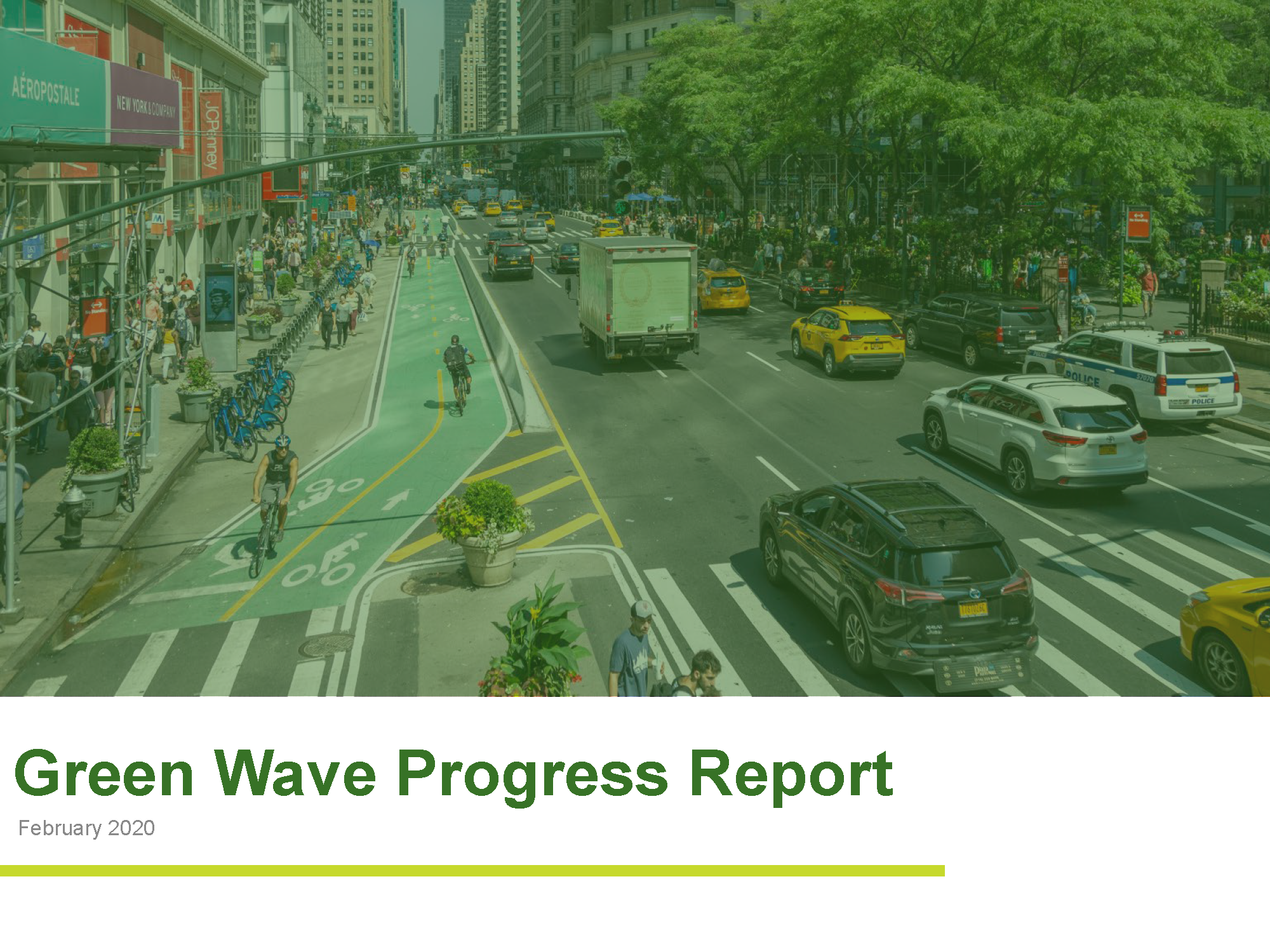
Green Wave Progress Report - February 2020
Mayor Bill de Blasio and Commissioner Polly Trottenberg today released a progress report on the Green Wave, the City’s plan to make streets safer for cyclists. The City has built 104 miles of protected bike lanes (PBLs) since 2014, including 21.4 miles completed in 2019. The de Blasio Administration has built over 400 miles of bike lanes since 2014.
The City will also construct approximately 10 new miles of protected bike lanes in Manhattan in 2020, including completing the Central Park West northbound protected lane and bringing the 6th Avenue northbound lane through Midtown to Central Park. These new projects are part of the Green Wave commitment to build 30 PBL miles across the city this year.
Green Wave Progress Report - February 2020

Mayor Bill de Blasio and Commissioner Polly Trottenberg today released a progress report on the Green Wave, the City’s plan to make streets safer for cyclists. The City has built 104 miles of protected bike lanes (PBLs) since 2014, including 21.4 miles completed in 2019. The de Blasio Administration has built over 400 miles of bike lanes since 2014.
The City will also construct approximately 10 new miles of protected bike lanes in Manhattan in 2020, including completing the Central Park West northbound protected lane and bringing the 6th Avenue northbound lane through Midtown to Central Park. These new projects are part of the Green Wave commitment to build 30 PBL miles across the city this year.
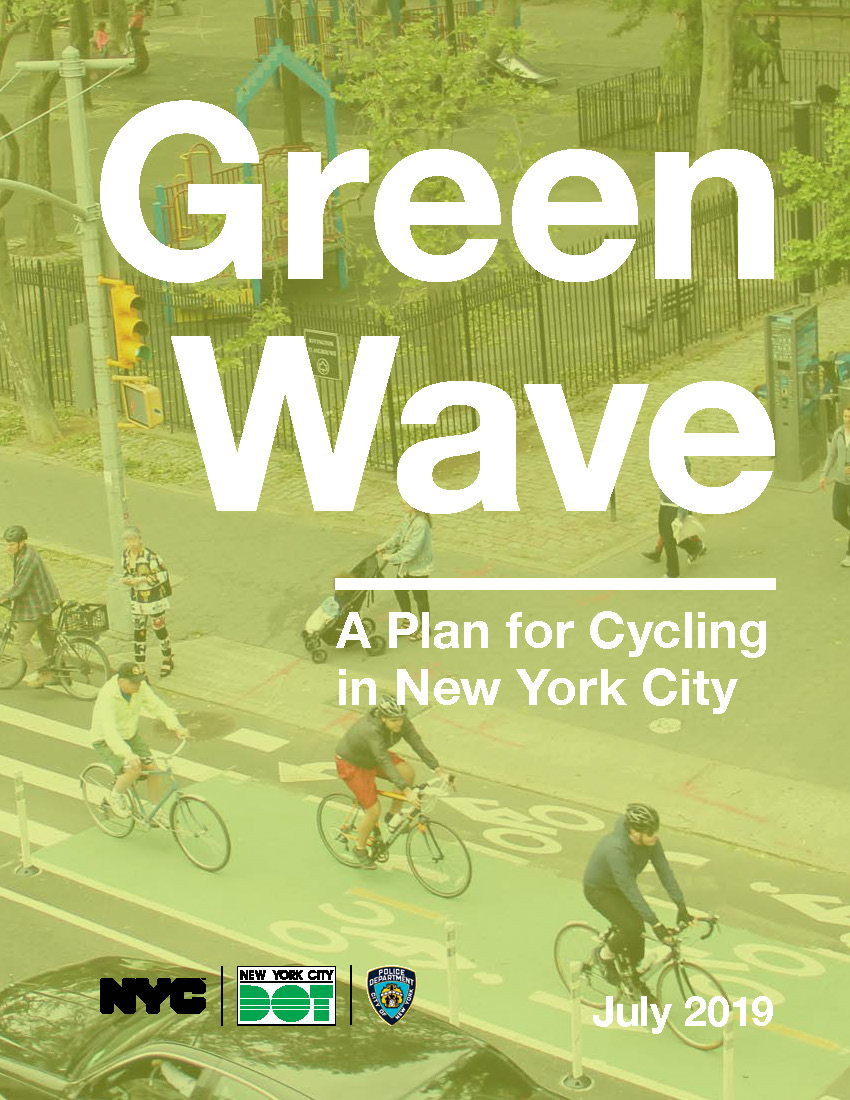
Green Wave: A Plan for Cycling in New York City - 2019
Mayor Bill de Blasio released “Green Wave: A Plan for Cycling in New York City” to confront the rise in cycling fatalities in 2019. As cycling continues to grow dramatically, the $58.4 million plan combines design, enforcement, legislation, policy and education to make the City’s streets safer for cyclists -- and all street users. With fatalities heavily concentrated this year in Brooklyn, the Mayor unveiled the plan in Bay Ridge, a neighborhood that this year will receive its first on-street protected lanes along 7th Avenue. The Mayor separately announced that as part of the accelerated expansion of the protected bike lane network, DOT would this year install a two-way protected bicycle lane along Dyckman Street in Washington Heights.
Green Wave: A Plan for Cycling in New York City - 2019

Mayor Bill de Blasio released “Green Wave: A Plan for Cycling in New York City” to confront the rise in cycling fatalities in 2019. As cycling continues to grow dramatically, the $58.4 million plan combines design, enforcement, legislation, policy and education to make the City’s streets safer for cyclists -- and all street users. With fatalities heavily concentrated this year in Brooklyn, the Mayor unveiled the plan in Bay Ridge, a neighborhood that this year will receive its first on-street protected lanes along 7th Avenue. The Mayor separately announced that as part of the accelerated expansion of the protected bike lane network, DOT would this year install a two-way protected bicycle lane along Dyckman Street in Washington Heights.
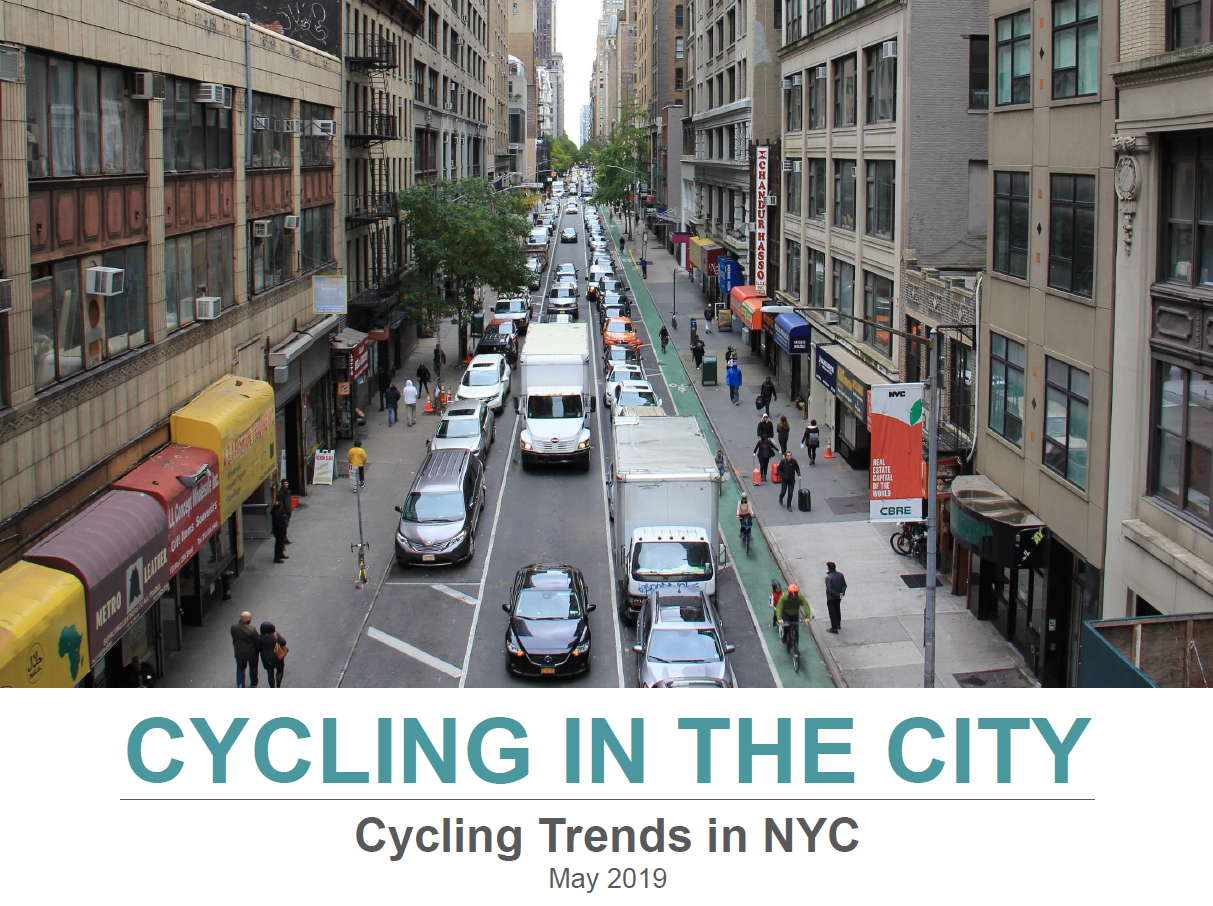
Cycling in the City - 2019
NYC DOT is pleased to announce the newest release of Cycling in the City, an annualized report on cycling trends in New York City. This brief examines data from the New York City Community Health Survey and national surveys, on-going bike counts, and Citi Bike to assess how frequently New Yorkers are using cycling as a mode of transportation and how that frequency is changing over time.
Cycling in the City - 2019

NYC DOT is pleased to announce the newest release of Cycling in the City, an annualized report on cycling trends in New York City. This brief examines data from the New York City Community Health Survey and national surveys, on-going bike counts, and Citi Bike to assess how frequently New Yorkers are using cycling as a mode of transportation and how that frequency is changing over time.

Cycling at a Crossroads
With turning vehicle conflicts combined with the high demand for street space, intersections remain one of the primary design challenges for creating a safe and comfortable bicycle network in New York City. This study aims to evaluate both new and traditional intersection design treatments and provide recommendations on their design and use.
Cycling at a Crossroads

With turning vehicle conflicts combined with the high demand for street space, intersections remain one of the primary design challenges for creating a safe and comfortable bicycle network in New York City. This study aims to evaluate both new and traditional intersection design treatments and provide recommendations on their design and use.
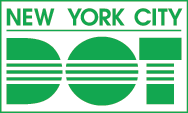
Bike Share Near Parks Report
This report contains an overview of New York City’s bike share system, Citi Bike, details how the program works, the planning and technical processes through which bike share station sites are selected, the potential usage of bike share near parks, and the regulatory and contractual barriers to installing bike share stations near parks.
Bike Share Near Parks Report

This report contains an overview of New York City’s bike share system, Citi Bike, details how the program works, the planning and technical processes through which bike share station sites are selected, the potential usage of bike share near parks, and the regulatory and contractual barriers to installing bike share stations near parks.
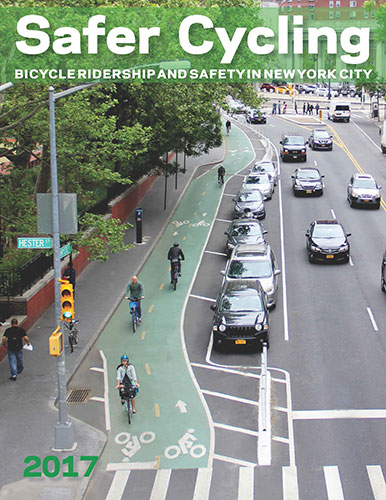
Safer Cycling: Bicycle Ridership and Safety in New York City
This comprehensive study analyzes growth of cycling and NYC’s bicycle network, noting that as the number of regular bicyclists has increased, cycling has grown dramatically safer.
Created in cooperation with agency partners at the New York City Police Department (NYPD) and the Department of Health and Mental Hygiene (NYC DOHMH), the study describes the progress New York City has made in improving cyclist safety, presents a detailed analysis of the factors that contribute to serious crashes involving cyclists, and lays out a comprehensive action plan to further improve cycling safety.
Learn more hereSafer Cycling: Bicycle Ridership and Safety in New York City

This comprehensive study analyzes growth of cycling and NYC’s bicycle network, noting that as the number of regular bicyclists has increased, cycling has grown dramatically safer.
Created in cooperation with agency partners at the New York City Police Department (NYPD) and the Department of Health and Mental Hygiene (NYC DOHMH), the study describes the progress New York City has made in improving cyclist safety, presents a detailed analysis of the factors that contribute to serious crashes involving cyclists, and lays out a comprehensive action plan to further improve cycling safety.
Learn more hereNYC Bike Share: Designed by New Yorkers
This report explains the multi-year public planning process used to create the Citi Bike program and determine where the stations would go – including 159 public meetings, the public suggestion website and the community workshop process.
NYC Bike Share: Designed by New Yorkers
This report explains the multi-year public planning process used to create the Citi Bike program and determine where the stations would go – including 159 public meetings, the public suggestion website and the community workshop process.


Cycling in the City - 2021
NYC DOT is pleased to announce the newest release of Cycling in the City, an annualized report on cycling trends in New York City. This brief examines data from the New York City Community Health Survey and national surveys, on-going bike counts, and Citi Bike to assess how frequently New Yorkers are using cycling as a mode of transportation and how that frequency is changing over time.
Cycling in the City - 2021 (PDF)
Cycling in the City - 2021

NYC DOT is pleased to announce the newest release of Cycling in the City, an annualized report on cycling trends in New York City. This brief examines data from the New York City Community Health Survey and national surveys, on-going bike counts, and Citi Bike to assess how frequently New Yorkers are using cycling as a mode of transportation and how that frequency is changing over time.
Cycling in the City - 2021 (PDF)

Green Wave Progress Report - February 2020
Mayor Bill de Blasio and Commissioner Polly Trottenberg today released a progress report on the Green Wave, the City’s plan to make streets safer for cyclists. The City has built 104 miles of protected bike lanes (PBLs) since 2014, including 21.4 miles completed in 2019. The de Blasio Administration has built over 400 miles of bike lanes since 2014.
The City will also construct approximately 10 new miles of protected bike lanes in Manhattan in 2020, including completing the Central Park West northbound protected lane and bringing the 6th Avenue northbound lane through Midtown to Central Park. These new projects are part of the Green Wave commitment to build 30 PBL miles across the city this year.
Green Wave Progress Report - February 2020

Mayor Bill de Blasio and Commissioner Polly Trottenberg today released a progress report on the Green Wave, the City’s plan to make streets safer for cyclists. The City has built 104 miles of protected bike lanes (PBLs) since 2014, including 21.4 miles completed in 2019. The de Blasio Administration has built over 400 miles of bike lanes since 2014.
The City will also construct approximately 10 new miles of protected bike lanes in Manhattan in 2020, including completing the Central Park West northbound protected lane and bringing the 6th Avenue northbound lane through Midtown to Central Park. These new projects are part of the Green Wave commitment to build 30 PBL miles across the city this year.

Green Wave: A Plan for Cycling in New York City - 2019
Mayor Bill de Blasio released “Green Wave: A Plan for Cycling in New York City” to confront the rise in cycling fatalities in 2019. As cycling continues to grow dramatically, the $58.4 million plan combines design, enforcement, legislation, policy and education to make the City’s streets safer for cyclists -- and all street users. With fatalities heavily concentrated this year in Brooklyn, the Mayor unveiled the plan in Bay Ridge, a neighborhood that this year will receive its first on-street protected lanes along 7th Avenue. The Mayor separately announced that as part of the accelerated expansion of the protected bike lane network, DOT would this year install a two-way protected bicycle lane along Dyckman Street in Washington Heights.
Green Wave: A Plan for Cycling in New York City - 2019

Mayor Bill de Blasio released “Green Wave: A Plan for Cycling in New York City” to confront the rise in cycling fatalities in 2019. As cycling continues to grow dramatically, the $58.4 million plan combines design, enforcement, legislation, policy and education to make the City’s streets safer for cyclists -- and all street users. With fatalities heavily concentrated this year in Brooklyn, the Mayor unveiled the plan in Bay Ridge, a neighborhood that this year will receive its first on-street protected lanes along 7th Avenue. The Mayor separately announced that as part of the accelerated expansion of the protected bike lane network, DOT would this year install a two-way protected bicycle lane along Dyckman Street in Washington Heights.

Cycling in the City - 2019
NYC DOT is pleased to announce the newest release of Cycling in the City, an annualized report on cycling trends in New York City. This brief examines data from the New York City Community Health Survey and national surveys, on-going bike counts, and Citi Bike to assess how frequently New Yorkers are using cycling as a mode of transportation and how that frequency is changing over time.
Cycling in the City - 2019

NYC DOT is pleased to announce the newest release of Cycling in the City, an annualized report on cycling trends in New York City. This brief examines data from the New York City Community Health Survey and national surveys, on-going bike counts, and Citi Bike to assess how frequently New Yorkers are using cycling as a mode of transportation and how that frequency is changing over time.

Cycling at a Crossroads
With turning vehicle conflicts combined with the high demand for street space, intersections remain one of the primary design challenges for creating a safe and comfortable bicycle network in New York City. This study aims to evaluate both new and traditional intersection design treatments and provide recommendations on their design and use.
Cycling at a Crossroads

With turning vehicle conflicts combined with the high demand for street space, intersections remain one of the primary design challenges for creating a safe and comfortable bicycle network in New York City. This study aims to evaluate both new and traditional intersection design treatments and provide recommendations on their design and use.

Bike Share Near Parks Report
This report contains an overview of New York City’s bike share system, Citi Bike, details how the program works, the planning and technical processes through which bike share station sites are selected, the potential usage of bike share near parks, and the regulatory and contractual barriers to installing bike share stations near parks.
Bike Share Near Parks Report

This report contains an overview of New York City’s bike share system, Citi Bike, details how the program works, the planning and technical processes through which bike share station sites are selected, the potential usage of bike share near parks, and the regulatory and contractual barriers to installing bike share stations near parks.

Safer Cycling: Bicycle Ridership and Safety in New York City
This comprehensive study analyzes growth of cycling and NYC’s bicycle network, noting that as the number of regular bicyclists has increased, cycling has grown dramatically safer.
Created in cooperation with agency partners at the New York City Police Department (NYPD) and the Department of Health and Mental Hygiene (NYC DOHMH), the study describes the progress New York City has made in improving cyclist safety, presents a detailed analysis of the factors that contribute to serious crashes involving cyclists, and lays out a comprehensive action plan to further improve cycling safety.
Learn more hereSafer Cycling: Bicycle Ridership and Safety in New York City

This comprehensive study analyzes growth of cycling and NYC’s bicycle network, noting that as the number of regular bicyclists has increased, cycling has grown dramatically safer.
Created in cooperation with agency partners at the New York City Police Department (NYPD) and the Department of Health and Mental Hygiene (NYC DOHMH), the study describes the progress New York City has made in improving cyclist safety, presents a detailed analysis of the factors that contribute to serious crashes involving cyclists, and lays out a comprehensive action plan to further improve cycling safety.
Learn more hereNYC Bike Share: Designed by New Yorkers
This report explains the multi-year public planning process used to create the Citi Bike program and determine where the stations would go – including 159 public meetings, the public suggestion website and the community workshop process.
NYC Bike Share: Designed by New Yorkers
This report explains the multi-year public planning process used to create the Citi Bike program and determine where the stations would go – including 159 public meetings, the public suggestion website and the community workshop process.

Bringing Equitable Bike Share to Bed-Stuy
Cities across the country are working with local partners to ensure that the benefits of bike share are equitable, and that bike share is accessible to people from all backgrounds. One such partnership, between Bedford Stuyvesant Restoration, NYC DOT, the NYC Department of Health, and Motivate (the operator of Citi Bike), successfully changed perceptions on bike share, from what some perceived to be an out-of-reach amenity for newer residents, to a tool that all residents can use to meet their own personal goals.
Learn more hereBringing Equitable Bike Share to Bed-Stuy
Cities across the country are working with local partners to ensure that the benefits of bike share are equitable, and that bike share is accessible to people from all backgrounds. One such partnership, between Bedford Stuyvesant Restoration, NYC DOT, the NYC Department of Health, and Motivate (the operator of Citi Bike), successfully changed perceptions on bike share, from what some perceived to be an out-of-reach amenity for newer residents, to a tool that all residents can use to meet their own personal goals.
Learn more hereBike Share Opportunities in New York City
This report analyzes existing bike-share models and current New York City bicyclist demographics and demand to assess the potential for a New York City Bike-Share Program. In addition, an overview of potential funding options and recommendations for program implementation, including suggested program size and phasing, bike-station siting, fees, safety and theft reduction, are also discussed. (Department of City Planning, 2009)
Bike Share Opportunities in New York City
This report analyzes existing bike-share models and current New York City bicyclist demographics and demand to assess the potential for a New York City Bike-Share Program. In addition, an overview of potential funding options and recommendations for program implementation, including suggested program size and phasing, bike-station siting, fees, safety and theft reduction, are also discussed. (Department of City Planning, 2009)

Bringing Equitable Bike Share to Bed-Stuy
Cities across the country are working with local partners to ensure that the benefits of bike share are equitable, and that bike share is accessible to people from all backgrounds. One such partnership, between Bedford Stuyvesant Restoration, NYC DOT, the NYC Department of Health, and Motivate (the operator of Citi Bike), successfully changed perceptions on bike share, from what some perceived to be an out-of-reach amenity for newer residents, to a tool that all residents can use to meet their own personal goals.
Learn more hereBringing Equitable Bike Share to Bed-Stuy
Cities across the country are working with local partners to ensure that the benefits of bike share are equitable, and that bike share is accessible to people from all backgrounds. One such partnership, between Bedford Stuyvesant Restoration, NYC DOT, the NYC Department of Health, and Motivate (the operator of Citi Bike), successfully changed perceptions on bike share, from what some perceived to be an out-of-reach amenity for newer residents, to a tool that all residents can use to meet their own personal goals.
Learn more hereBike Share Opportunities in New York City
This report analyzes existing bike-share models and current New York City bicyclist demographics and demand to assess the potential for a New York City Bike-Share Program. In addition, an overview of potential funding options and recommendations for program implementation, including suggested program size and phasing, bike-station siting, fees, safety and theft reduction, are also discussed. (Department of City Planning, 2009)
Bike Share Opportunities in New York City
This report analyzes existing bike-share models and current New York City bicyclist demographics and demand to assess the potential for a New York City Bike-Share Program. In addition, an overview of potential funding options and recommendations for program implementation, including suggested program size and phasing, bike-station siting, fees, safety and theft reduction, are also discussed. (Department of City Planning, 2009)
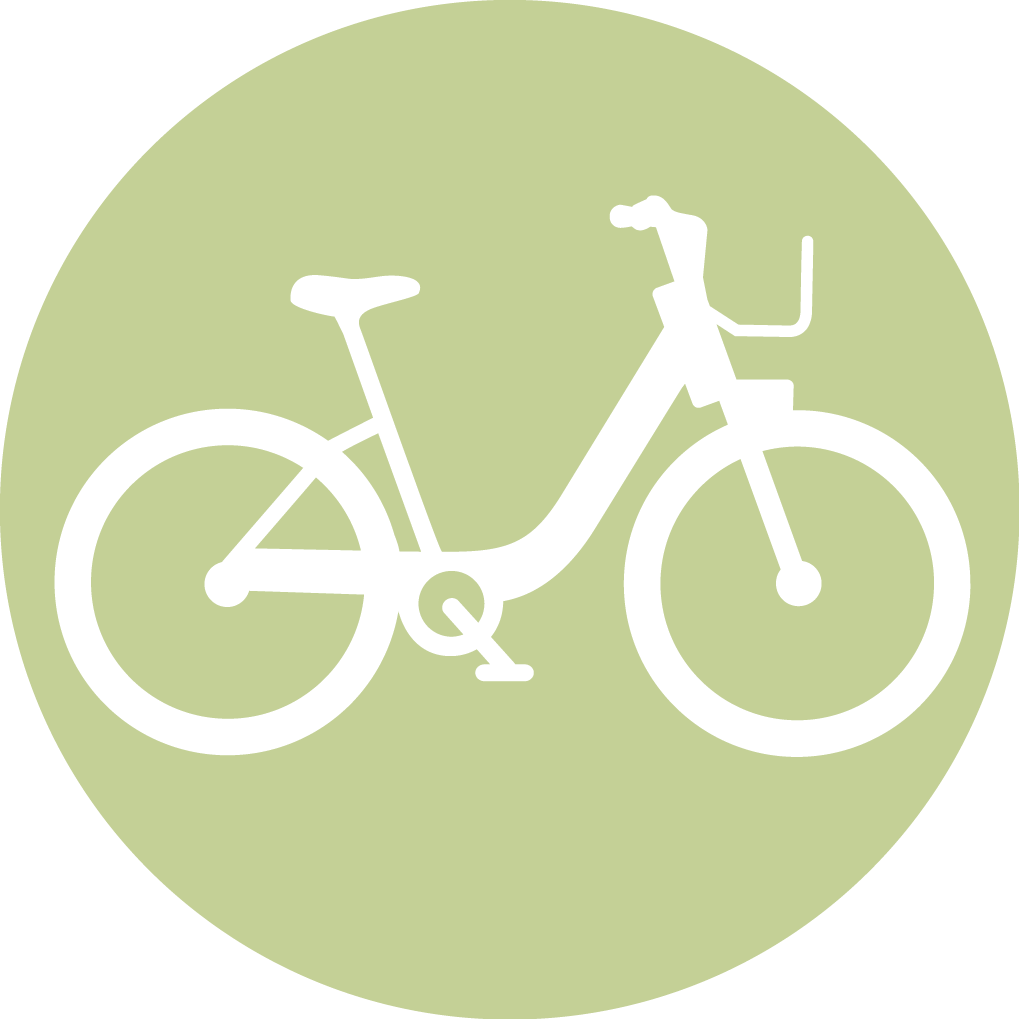
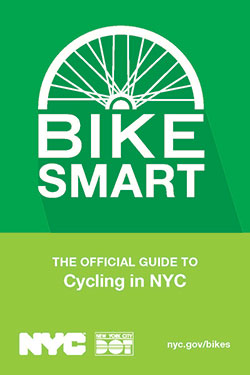
Tips for Riding in the City!
Riding a bike in New York City has never been safer. New York City has installed more than 769 lane-miles of bicycle routes since 2002, and there are now more than 1,100 miles of bike lanes city-wide including parks and greenways.
Download Bike Smart: The Official Guide to Cycling in New York City (PDF). This is a helpful guide that contains information on rules for cyclists, how to use new bike facilities such as protected lanes and bike boxes and more.
Need a Helmet?
NYC DOT has distributed more than 180,000 free helmets to New York City residents. Learn how to get yours.
Ready to Ride?
Download the official NYC Bike map or call 311 to order a paper copy.
Tips for Riding in the City!

Riding a bike in New York City has never been safer. New York City has installed more than 769 lane-miles of bicycle routes since 2002, and there are now more than 1,100 miles of bike lanes city-wide including parks and greenways.
Download Bike Smart: The Official Guide to Cycling in New York City (PDF). This is a helpful guide that contains information on rules for cyclists, how to use new bike facilities such as protected lanes and bike boxes and more.
Need a Helmet?
NYC DOT has distributed more than 180,000 free helmets to New York City residents. Learn how to get yours.
Ready to Ride?
Download the official NYC Bike map or call 311 to order a paper copy.


Tips for Riding in the City!
Riding a bike in New York City has never been safer. New York City has installed more than 769 lane-miles of bicycle routes since 2002, and there are now more than 1,100 miles of bike lanes city-wide including parks and greenways.
Download Bike Smart: The Official Guide to Cycling in New York City (PDF). This is a helpful guide that contains information on rules for cyclists, how to use new bike facilities such as protected lanes and bike boxes and more.
Need a Helmet?
NYC DOT has distributed more than 180,000 free helmets to New York City residents. Learn how to get yours.
Ready to Ride?
Download the official NYC Bike map or call 311 to order a paper copy.
Tips for Riding in the City!

Riding a bike in New York City has never been safer. New York City has installed more than 769 lane-miles of bicycle routes since 2002, and there are now more than 1,100 miles of bike lanes city-wide including parks and greenways.
Download Bike Smart: The Official Guide to Cycling in New York City (PDF). This is a helpful guide that contains information on rules for cyclists, how to use new bike facilities such as protected lanes and bike boxes and more.
Need a Helmet?
NYC DOT has distributed more than 180,000 free helmets to New York City residents. Learn how to get yours.
Ready to Ride?
Download the official NYC Bike map or call 311 to order a paper copy.

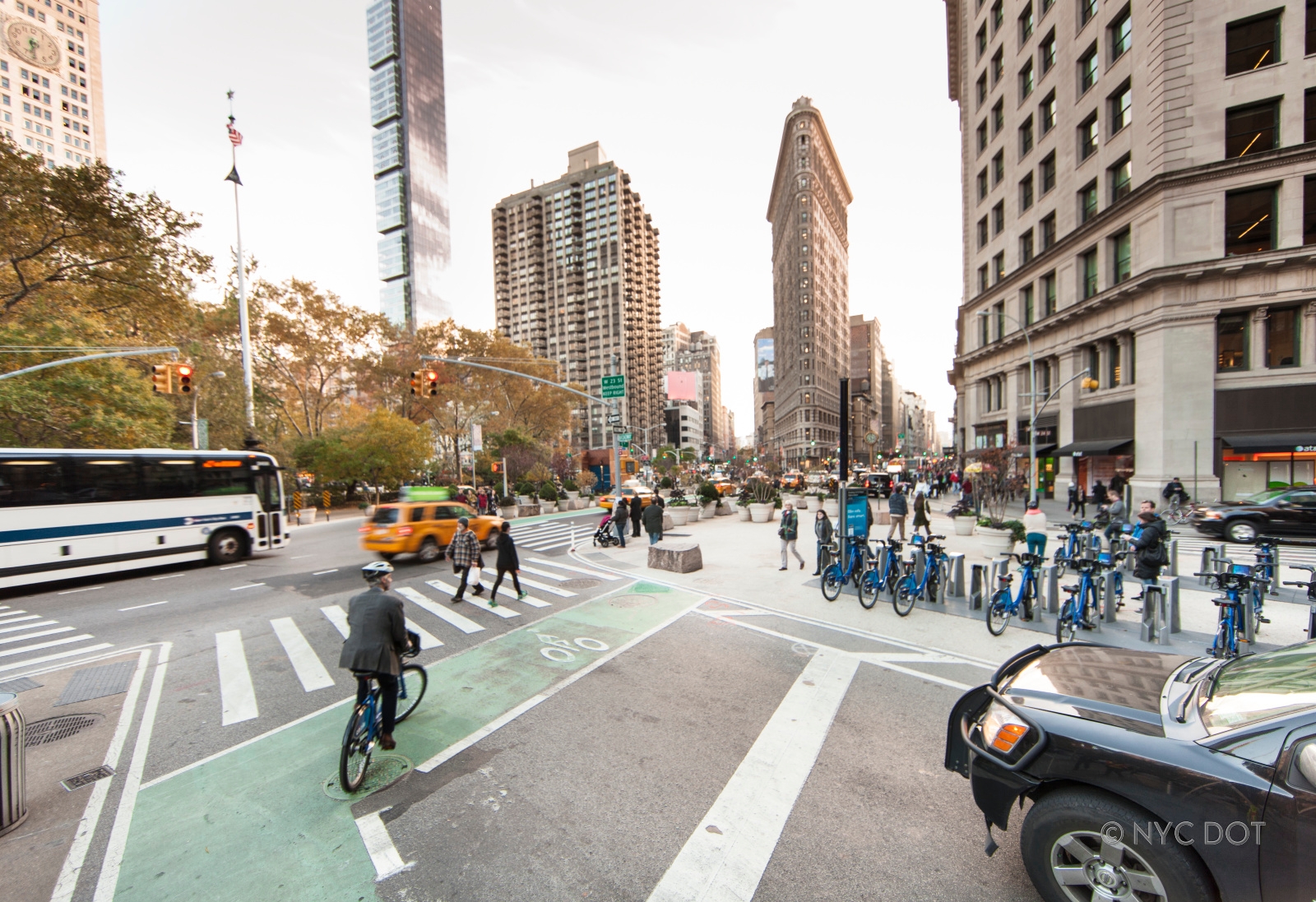
Bike Share Trip Histories
NYC DOT Bike Network & Stats

